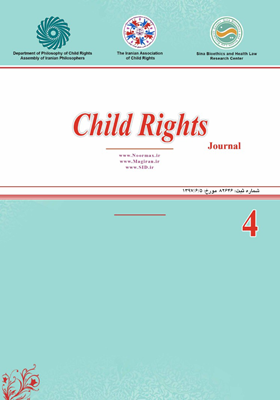حمایت از کودکان در برابر بازیهای رایانهای نامناسب و زیانبار
الموضوعات : child rightsمحمدجواد عربیان 1 , سیدهپریسا میرابی 2 , علی زند 3
1 - دکترای حقوق بینالملل و پژوهشگر حقوق بینالملل سایبری، تهران، ایران
2 - دانشجوی دکتری حقوق بینالملل، دانشگاه آزاد اسلامی، واحد نجفآباد، نجفآباد، ایران
3 - تهران/دانشگاه آزاد اسلامی، واحد پردیس
الکلمات المفتاحية: بازیهای رایانهای, حقوق, حمایت از کودکان, حق بر شادی,
ملخص المقالة :
استفاده از بازیهای رایانهای در میان کودکان به سرعت در حال گسترش است و به یکی از ابعاد عادی زندگی روزمره تبدیل شده است. این بازیها با برخورداری از پتانسیلهای نوآورانه میتواند انگیزههای درمانی، تقویت مهارتهای کاربردی و تسهیل در تعالیم و مفاهیم درسی را فراهم آورد. علاوه بر ابعاد مثبت این بازیها واجد آثار و عوارض منفی بوده و از سوی دیگر غرقشدن کورکوانه کودکان و نوجوانان در فضای بازیهای رایانهای برابر خواهد بود، با غوطهوری شرکتهای سازنده این بازیها در سودها و منافع سرشار. این پژوهش با هدف تضمین حق بازی، شادی و سرگرمی، به روش توصیفی ـ تحلیلی با استفاده از قوانین و مقررات داخلی و میثاقهای بینالمللی و سایر منابع کتابخانهای، به حمایت از حقوق کودکان در برابر بازیهای زیانبار با توسل به نظریههای جامعهشناختی، قوانین داخلی و اسناد بینالمللی را مورد مداقه قرار داده است. این تحقیق بر آن است تا با بررسی فواید و مضرات بازیهای رایانهای به تشریح انواع حمایت و بیان الزامات و بایستههای قانونی حمایت و مصونسازی استفادهکنندگان از عوارض نامناسب زیانبار این بازیها بپردازد.
1. Chahardouli Z. As Voting Characters in Promotion of International Peace and Security, Proceedings of the Conference on International Law and Computer Games. Tehran: Mizannsher Publication; 2019. p.331.
2. Elsan M. Cyberspace Rights. Tehran: Shahredanesh Publishing The SD Institute of Law Reseach and Study; 2017. p.220.
3. Zandi MR. Preliminary research on cybercrime. Tehran: Jungle Publications; 2014. p.17.
4. Moini L. Using New Tools and Summaries in Teaching Human Rights to Youth, Online Computer Games Using the Server, Proceedings of the Conference on International Law and Computer Games. Tehran: Mizannsher Publication; 2019. p.196.
5. Mirabi SP, Zand A. Strategies for Preventing Delinquency of Children and Adolescents in Cyberspace. Maragheh: Second National Conference on Cyber Defense, Maragheh University; 2019.
6. Arabo A. Cyber Security Challenges within the Connected Home Ecosystem Futures.ELSEVIER. Procedia Computer Science 2015; 61: 227-232. Available at: http://www.sciencedirect.com.
7. Salahi J. Child and adolescent delinquency. The Legal Foundation of the extent. Tehran: Mizannsher Publication; 2009. p.78-79.
8. Amali SSR. A Two-Spatial Approach to Injury, Crime, Cyberspace Laws and Policies. Tehran: Amir Kabir Publishing; 2011. p.527.
9. Hosseini SD. Computer Games (A Look at Features, Musts and Don'ts). Journal of Rah Avard Noor 2012; 3(36): 28-33.
10. Zamani SGH. The Role of Computer Games in Children's Human Rights Education, Proceedings of the Conference on International Law and Computer Games. Tehran: Publishing Mizan; 2019. p.156.
11. Hosseini SH. Sociological Analysis of the Internet Relationship and Drug Addiction by Relying on Computer Communication Network Interfaces. Journal of Cultural Studies and Communication 2005; 2(3): 1-18.
12. Mir Mohammad Sadeghi H. Crimes against public security and comfort. Tehran: Extent; 2013. Chab.21.
13. Alipour H. Computer scam. Journal of Legal Research 2004; 3(6): 203-238.
14. Prensky M. Computer games and Learning: Digital game based learning. In Raessens J, Goldstein J. Cambridge: Handbook of computer Game Studies; 2005. p.101.
15. Brezinka V. Computer games supporting cognitive behaviour therapy in children. Clinical Child Psychology and Psychiatry 2014; 19(1): 100-110.
16. Brown SJ, Lieberman DA, Gemeny BA, Fan YC, Wilson DM, Pasta DJ. Educational video game for juvenile diabetes: Results of a controlled trial. Medical Informatics 1997; 22(1): 77-89.
17. Kato PM, Cole SW, Bradlyn AS, Pollock BH. A video game improves behavioral outcomes in adolescents and adults with cancer: A randomized trial. Pediatrics 2008; 122(2): e305-e317.
18. Olarte CR, López DM, Narváez S, Farinango CD, Pharow PS. A computer game to support cognitive therapies in children. Psychology Research and Behavior Management 2017; 10: 208-217.
19. Sakai T, Tamaki H, Yoshida R, Egusa R, Inagaki S, Yamaguchi E, et all. COSEY: Computer Supported Enhancement of Young Children’s Cooperation-Toward a Multiple-player Cooperative Full-body Interaction Game. Rome: 8th International Conference on Computer Supported Education; 2016. Vol.2 p.175-180.
20. Nasirzadeh S. Information technology and its role in the teaching and learning of students with cerebral palsy. Exceptional Education 2013; 13(5): 56-67.
21. Habiba S, Hosseinzadeh M. Investigating the Process of Legal Protection of Computer Games in the Intellectual Property System. Legal Research Quarterly 2013; 16(153): p37-68.
22. Mirshamsi H. Supporting Computer Games in International Intellectual Property Law, Proceedings of the Conference on International Law and Computer Games. Tehran: Mizannsher Publication; 2019.
23. Latonero M. Human Trafficking Online: The Role of Social Networking Sites and Online Classifides. USC, Annenberg: Centre on Communication Leadership & Policy; 2011. p.31-32. Available at: http://dx.doi.org/10.2139/ssrn.2045851.
24. Moazami SH. Juvenile delinquency. Tehran: Justice Publishing; 2016. p.162.
25. Abouzari M. Attitude to Criminal Law. Tehran: Audience Publication; 2017.
26. Masafa N. Children's Right to Play and Play Computer Games, Proceedings of the Conference on International Law and Computer Games. Tehran: Mizannsher Publication; 2019. p.147.
27. United Nations Office on Drugs and Crime Vienna. Study on the Effects of New Information Technologies on the Abuse and Exploitation of Children; 2015. p.38.


